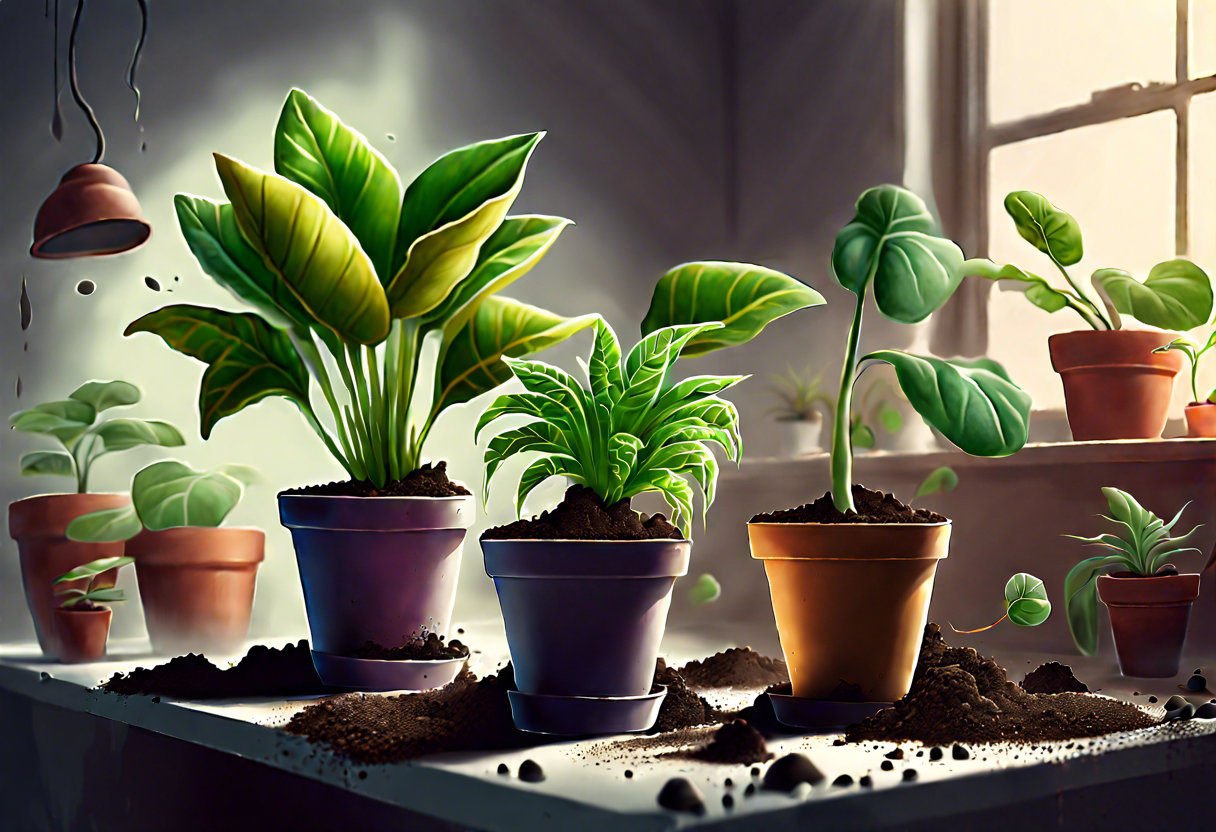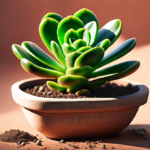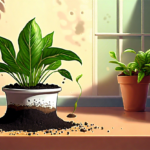Benefits of Repotting Houseplants Soil
When it comes to the wellbeing of your houseplants, repotting them can offer numerous benefits. Repotting refers to the process of transferring a plant into a new pot with fresh soil. This practice plays a vital role in maintaining healthy growth and overall plant development. In this article, we will explore the advantages of repotting houseplant soil and why it is essential for their long-term health.
One of the primary benefits of repotting houseplant soil is providing adequate space for root growth. Over time, the roots of houseplants outgrow their current pot, leading to root-bound conditions. When the root ball becomes tightly packed, it restricts the plant from absorbing essential nutrients and moisture from the soil. Repotting the plant into a larger pot allows the roots to spread out, leading to healthier and stronger growth.
Another advantage of repotting houseplant soil is the opportunity to refresh the potting mix. Over time, the nutrients in the soil become depleted, making it less effective in supporting plant growth. By repotting, you can provide fresh potting mix with an optimal nutrient balance, ensuring that your houseplants receive the necessary nourishment for thriving. Additionally, repotting helps to remove any accumulated salts or toxins in the soil that may have built up over time.
Repotting houseplant soil also offers the opportunity to inspect the roots for any signs of damage or disease. During the repotting process, you can carefully examine the roots and trim away any damaged or rotting parts. This not only promotes better overall plant health but also prevents the spread of diseases that can harm the entire plant.
Moreover, repotting houseplants soil can enhance the overall aesthetic appeal of your indoor garden. Transferring your plants to a new pot gives you the chance to choose a style and size that complements your home decor. This allows you to create a visually pleasing display and add a touch of freshness to your living space.
Repotting houseplant soil brings several benefits to the health and appearance of your indoor plants. By providing adequate root space, refreshing the potting mix, inspecting roots for damage, and improving the overall aesthetics, repotting ensures that your plants thrive and continue to enhance your living environment. Regular repotting is an essential practice for any plant enthusiast who wants to enjoy the full benefits of their houseplants. So, give your plants the TLC they deserve and watch them flourish in their new pot!
Signs that Indicate Houseplants Need Repotting
Houseplants require repotting at some point in their growth cycle to ensure their proper development and overall health. It allows them to have adequate space for their roots to expand and access the necessary nutrients in the soil. However, determining when a houseplant needs repotting can sometimes be challenging. Here are some signs to look out for:
1. Root Overgrowth: If you notice that the roots of your houseplant are growing out of the drainage holes in the pot or becoming tightly packed, it is a clear indication that repotting is necessary. Overgrown roots restrict the plant’s ability to absorb water and nutrients, affecting its growth.
2. Stunted Growth: When a houseplant outgrows its current pot, its growth may become stunted. If you observe that your plant is not thriving as it should be or shows signs of wilting despite adequate care, repotting could be the solution. A larger pot with fresh soil will give the plant more space to grow and flourish.
3. Water Drainage Issues: Poor water drainage can be a sign that your houseplant needs repotting. If you notice excessive water pooling on the soil’s surface or taking a long time to drain, it could indicate that the potting soil is compacted, preventing proper drainage. Repotting will provide more opportunity for the water to flow through the soil and avoid waterlogged conditions.
4. Nutrient Depletion: Over time, the nutrients in the potting soil become depleted as the plant absorbs them for growth. If you notice slowed growth or pale leaves, it may be an indication that your houseplant needs a fresh supply of nutrients. Repotting with fresh potting mix will replenish the nutrient levels and support healthy growth.
5. Pot-bound Roots: If you gently remove your houseplant from its pot and find that the root ball is tightly packed and circling around, the plant is root-bound and needs repotting. Pot-bound roots limit proper nutrient absorption and restrict the plant’s ability to grow. Repotting will allow the roots to spread out and develop properly.
By observing these signs, you can determine when it’s time to repot your houseplants. Repotting at the right time will provide them with the necessary space and nutrients for optimal growth and vibrant foliage.
The Importance of Choosing the Right Potting Mix for Repotting Houseplants
When it comes to repotting your houseplants, one crucial aspect to consider is the type of potting mix you use. Choosing the right potting mix is essential for the overall health and well-being of your plants. It provides the necessary nutrients, aeration, and drainage required for them to thrive.
One key consideration is the composition of the potting mix. A good potting mix should be lightweight and well-draining to prevent waterlogging, which can lead to root rot. It should also retain moisture to ensure that the plant’s roots have adequate hydration. Well-draining potting mixes typically contain a combination of organic matter, such as peat moss or coconut coir, and inorganic materials like perlite or vermiculite.
Another important factor to consider is the nutrient content of the potting mix. Houseplants rely on the nutrients present in the soil to support their growth and development. The potting mix should ideally contain a balanced blend of macronutrients (nitrogen, phosphorus, and potassium) and micronutrients (calcium, magnesium, iron, etc.). slow-release fertilizers into the potting mix can provide a steady supply of nutrients to the plants over an extended period.
In addition to nutrient content, the pH level of the potting mix is also crucial. Different houseplants have varying pH requirements, and using a potting mix with the appropriate pH can significantly improve their overall health. Most houseplants thrive in slightly acidic to neutral pH levels, ranging from 5.5 to 7.0. Testing the pH of the potting mix can be done using a simple soil pH testing kit.
When repotting houseplants, it’s essential to consider the specific requirements of the plants you are working with. Some plants prefer well-draining potting mix, while others may require a more moisture-retaining medium. Understanding the needs of your plants will help you make an informed decision when selecting the potting mix.
Remember that not all potting mixes are created equal, and using garden soil alone is not recommended for potted houseplants. Garden soil tends to be heavy and dense, which can lead to poor drainage and compaction in containers. It may also contain weed seeds or pathogens that could harm your plants. Opting for a high-quality, well-balanced potting mix specially formulated for indoor plants is the best bet for success.
Choosing the right potting mix is vital for repotting houseplants. It provides the necessary nutrients, aeration, and moisture retention that houseplants need to thrive. Consider the composition, nutrient content, and pH level of the potting mix to meet the specific requirements of your plants. By doing so, you ensure that your houseplants have the best chance of flourishing in their new pots.
Step-by-Step Guide to Repotting Houseplants Successfully
Repotting houseplants is an essential task that helps promote healthy growth and longevity. Whether your plants have outgrown their current pots or need fresh soil, repotting can help rejuvenate them. Here is a step-by-step guide to successfully repotting your houseplants.
Step 1: Choose the right time
The best time to repot your houseplants is during the spring or early summer when they enter their active growth phase. Avoid repotting during the dormant season as it may cause unnecessary stress to the plants.
Step 2: Select the appropriate pot
Choose a pot that is slightly larger than the current one. Ensure the pot has drainage holes to prevent waterlogging. Avoid using pots that are too large as they can retain excess moisture, leading to root rot.
Step 3: Gather the necessary tools
You will need a few tools for repotting, including a trowel or a small shovel, a watering can, and a pair of gardening gloves. Having these tools ready beforehand will make the repotting process smoother.
Step 4: Prepare the new pot
Before transferring the plant, add a layer of fresh, well-draining potting mix at the bottom of the new pot. This layer will provide the plant with a nourishing base and ensure proper drainage.
Step 5: Carefully remove the plant
Gently tap the sides of the current pot to loosen the plant’s root ball. Then, grasp the base of the plant’s stem and carefully lift it out of the pot. Be cautious not to damage the roots during this process.
Step 6: Inspect the roots
Once the plant is out of the pot, examine its roots. Trim any damaged or rotting roots using clean, sharp pruning shears. This step promotes healthy growth and prevents potential diseases.
Step 7: Place the plant in the new pot
Position the plant in the center of the new pot, ensuring that it sits at a similar depth as it did in the previous pot. Gently fill the sides with fresh potting mix, pressing it down lightly to eliminate air pockets.
Step 8: Water the plant
After repotting, give the plant a good watering. This will help settle the soil and provide essential moisture to the roots. Allow any excess water to drain out from the pot’s holes.
Step 9: Adjust watering and care routine
After repotting, it’s crucial to adjust your watering and care routine to accommodate the plant’s new environment. Avoid overwatering or underwatering, as both can stress the plant.
Following these steps will ensure that your houseplants are successfully repotted. Repotting offers numerous benefits, including better nutrient uptake, improved drainage, and enhanced overall plant health. Remember, healthy plants thrive when provided with the right soil and adequate space for root growth. So, give your houseplants the care they deserve by repotting them when needed.
Common Mistakes to Avoid When Repotting Houseplants Soil
Repotting houseplants is an essential task for plant lovers to ensure the health and growth of their indoor foliage. However, it is crucial to approach this task with care and attention to prevent potential mistakes that could harm the plants. By avoiding these common pitfalls, you can successfully repot your houseplants and promote their well-being.
1. Using the wrong pot size: One of the most common mistakes people make when repotting houseplants is choosing the wrong pot size. It’s important to select a pot that is only slightly larger than the current one. If the new pot is too large, it can trap excess moisture and lead to root rot. Additionally, an oversized pot may cause the plant’s energy to focus on root development instead of foliage growth.
2. Neglecting to loosen the roots: When repotting, it’s crucial to loosen the root ball gently. Neglecting this step can result in the roots becoming compacted and preventing proper nutrient absorption. Gently teasing the roots can encourage new root growth and enhance the overall health of the plant.
3. Choosing the wrong potting mix: Selecting the right potting mix is essential for the successful repotting of houseplants. Avoid using garden soil alone, as it tends to be too heavy and can suffocate the roots. Instead, opt for a well-draining potting mix that is specifically formulated for indoor plants. These mixes often contain a balanced blend of organic matter, perlite, and vermiculite, which provide excellent drainage while retaining moisture.
4. Overwatering after repotting: Many people make the mistake of overwatering their houseplants after repotting. This can lead to waterlogged roots and subsequent root rot. Remember that repotting can temporarily disrupt the root system, so it’s crucial to avoid excessive watering. Instead, water the plant sparingly and gradually increase the frequency as it adjusts to its new pot.
5. Failing to provide proper aftercare: After repotting, houseplants require some time to acclimate. Avoid placing them in direct sunlight immediately after repotting, as this can cause stress to the plant. Instead, find a spot that offers indirect light and gradually reintroduce them to their preferred lighting conditions over several days. Additionally, monitor the plant closely for any signs of stress or disease and provide the necessary care accordingly.
By avoiding these common mistakes, you can ensure successful repotting of your houseplants and promote their optimal growth and health. Remember to choose the right pot size, loosen the roots, select a suitable potting mix, water appropriately, and provide proper aftercare. With these steps in mind, your houseplants will thrive and add beauty to your indoor space for years to come.
Conclusion
Repotting houseplants soil offers numerous benefits that can greatly enhance the health and vitality of your indoor plants. By providing fresh soil and a larger container, you are stimulating growth and ensuring proper root development. The signs that indicate your houseplants need repotting, such as roots poking out of the drainage holes and slower growth, should not be ignored. It is equally important to choose the right potting mix, as different plants have different soil preferences. Using a high-quality mix that is well-draining and nutrient-rich will give your plants the best chance to thrive.
Following a step-by-step guide to repotting houseplants will help you carry out the process successfully. Start by choosing a suitable pot that provides ample space for root growth. Gently loosen the plant from its existing pot, being careful not to damage the roots. Remove any dead or decaying roots and transfer the plant to its new container, ensuring it is positioned at the same depth as before. Fill in the gaps with fresh potting mix and water the plant thoroughly. place the newly repotted plant in a suitable location and monitor its progress.
While repotting your houseplants can be beneficial, it is important to avoid some common mistakes. One common error to avoid is choosing a pot that is too large for your plant. Although the instinct may be to provide more space, an excessively large pot can lead to overwatering and root rot. Additionally, failing to use a well-draining potting mix can cause waterlogged soil and suffocate the roots. Overwatering, insufficient drainage, and neglecting to monitor the moisture levels of the soil are other common mistakes that should be avoided.
Repotting houseplant soil is a crucial aspect of indoor plant care. The benefits it offers, such as promoting growth and ensuring root health, make it an essential practice for plant enthusiasts. Recognizing the signs that your houseplants need repotting and selecting the appropriate potting mix are crucial steps in the process. Following a step-by-step guide and avoiding common mistakes will contribute to the success of repotting your houseplants. By understanding the importance of repotting houseplants soil and implementing the necessary measures, you can provide your indoor plants with the optimal growing conditions for their overall well-being.


